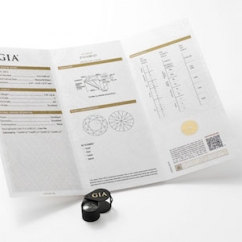Articles and News
High-End Stones Impacted Most By GIA Grading Report Breach | October 27, 2015 (0 comments)

Carlsbad, CA—When GIA alerted the trade last Friday that a major breach of proprietary data had forced it to invalidate grading reports for 1,042 diamonds, the most immediate question was, where are those diamonds now?
GIA was forthright about what happened: an outside party gained unauthorized remote access to its grading information database and altered the reports. The list of invalidated reports, available on GIA’s website, shows the weight and shape of the impacted stones, but not the color or clarity grade. “Because the reports were altered, we don’t know what the real colors or clarities are,” says Stephen Morisseau, GIA director of public relations. “That’s why we’re asking anyone who has one of these stones to submit it for re-examination.” Affected stones will be reexamined at no cost, Morisseau told The Centurion.
The majority of stones affected are between one and three carats, with some as large as five carats, which suggests that high-end jewelers and manufacturers are the sector most likely to be in possession of the impacted stones. Most are round brilliants, but a number of cushions and squares are on the list, along with a smattering of other shapes—pears, ovals, emerald cuts, marquise, and heart.
Morisseau says GIA has no way of knowing how far down the distribution pipeline the stones have gone. The impacted stones were submitted to GIA for grading between November 2014 and September 2015, primarily to its lab in India, but some were submitted directly to Carlsbad or New York. The bulk of them—approximately 900 of the total—were submitted in July and August. It is therefore possible that some of the stones from the batch are already in U.S. retailers’ showcases or in consumers’ jewelry boxes.
Retailers who suspect they have—or have sold—one of the impacted stones should call GIA and call the supplier from whom they purchased the stone. If they have in fact sold one, they’ll have to let those customers know—which Morisseau acknowledges won’t be a pleasant or easy call to make—but GIA will reexamine the stones at no cost.
Morisseau emphasized that the breach was not a random hacking job of the kind that happened to Target or Neiman Marcus. Based on discrepancies in grading information identified by internal controls, GIA initiated an investigation in conjunction with Tata Consultancy Services (TCS), the contractor that supports GIA databases. The investigation indicated that former employees of TCS made the unauthorized changes. The individuals, acting at the behest of other parties unrelated to GIA or TCS, gained unauthorized remote access to alter grades before reports were printed and sent to clients.
“This was not a teenager in Hoboken hacking into GIA’s database,” Morisseau told The Centurion. “These were people who had a connection and knew what they were looking for.” Based on GIA’s investigation thus far, only those 1,042 stones seem affected, he said.
GIA and TCS are cooperating with law enforcement agencies in India that are actively investigating the matter. By Monday, two suspects, both former TCS employees, were in custody. The clients who submitted the diamonds in question were contacted and suspended from further submissions to GIA on Friday pending continued investigation; GIA released the names of those clients to the trade on Monday. Click here to download the updated list of the invalidated reports with the names of the submitting clients.
“GIA is very appreciative of the efforts made by TCS to identify the affected reports and for their open and transparent cooperation during the investigation. We have further strengthened our systems, controls and procedures for access to our grading information database,” said a GIA statement.
Once again, Morisseau told The Centurion that GIA strongly requests anyone in possession of any of these diamonds or grading reports return them immediately to GIA for examination. “GIA takes very seriously our mission to protect the public trust in gems and jewelry. Any attempt to mislead regarding the nature and qualities of any gem is unacceptable.”
Top image: GIA blog







